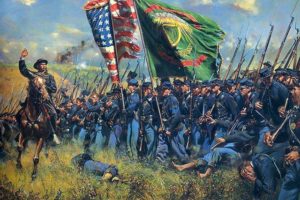Mid-March brings us parades, green beer, shamrocks, and green attire in commemoration of the death of St. Patrick, patron saint of Ireland. This once solemn day has morphed into an Irish-American cultural festival and has lost much (perhaps all) of its religious importance. Not wanting to miss out on what seems like a great holiday, St. Patrick is now honored with parades all around the world, including some of the most unlikeliest places: Russia, South Korea, and Malaysia. Even the International Space Station celebrates St. Patrick.
St. Patrick remains a mysterious figure. He is known best for the myth that he expelled snakes from Ireland (never mind that there likely were never any snakes there to expel). His real accomplishment was in converting the pagans of Ireland to Christianity. The Irish love their patron saint, but lost in this focus on St. Patrick is the work of many other important Irish men and women.
The descendants of Irish immigrants have proven to be among the most important and influential Americans. Of our past 10 Presidents, 9 had Irish blood (Kennedy, Johnson, Nixon, Carter, Reagan, Bush 1, Clinton, Bush 2, Obama). Ford is the only President missing in that chain. President Trump has no known Irish ancestors, but he may be the only one who had a mother that spoke Gaelic. She came from an island off of Scotland where the Irish language was spoken.
I recently listened to The Immortal Irishman: The Irish Revolutionary Who Became an American Hero, by Timothy Egan. The book is about Thomas Francis Meagher (pronounced Mahr). A hero of the Irish Rebellion of 1848, Meagher led an amazing life. He defied death several times. He was sentenced to be hung, drawn, and quartered for his revolutionary activities. From the dock, he taunted his judges with defiance:
“Proceed, then my lords, with that sentence which the law directs—I am prepared to hear it—I trust I am prepared to meet its execution. I shall go, I think, with a light heart before a higher tribunal—a tribunal where a Judge of infinite goodness, as well as of infinite justice, will preside, and where, my lords, many, many of the judgements of this world will be reversed.”
Of course there wouldn’t be much more to say about Thomas Meagher if he had been executed. The Queen gave him a reprieve and had him shipped off to the prison colony of Tasmania (known then as Van Diemen’s Land). He escaped from there, but almost lost his life after spending four days at sea in a lifeboat.
Saved by an American whaling vessel, Meagher was brought to San Francisco and eventually made his way to New York. There, he made a living giving lectures and continued his revolutionary zeal.
During the Civil War, he was a brigadier general and he recruited and led the 69th Irish Brigade, one of the most fearsome brigades in the Union Army. The “Fighting 69th” suffered more battle deaths than all other brigades but two. Under its war cry “Faugh a Ballaugh” (clear the way), Gen, Meagher developed a reputation that terrified his southern opponents.
Barely surviving the Civil War, Meagher became Acting Governor of Montana Territory, but at the young age of 43, he mysteriously fell overboard from a riverboat on the Missouri River. Some have speculated that he was murdered by political opponents from Montana or by British agents intent on silencing the Irish revolutionary or perhaps by Confederate veterans seeking revenge.
Meagher is a hero to the Irish. Statues of him sit in his hometown of Waterford and in his final home of Helena, Montana. There is a monument in his honor at the Antietam battlefield and his name adorns many public spaces in Ireland and in the United States, including Meagher County, Montana.
While we celebrate the many myths of Ireland’s Patron Saint with green beer this month, let’s also remember the many Irish heroes who have helped shaped our country with their words, their actions, and their blood.
In Liberty,
Ken Mandile
Senior Fellow
Worcester Tea Party


You must be logged in to post a comment.